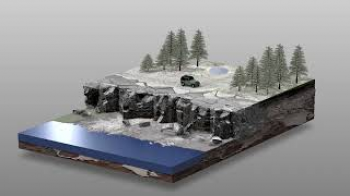Permafrost thaw video
updated 2021
Permafrost is soil that stays at a temperature of below zero degrees centigrade for two or more years. Covering 20% of Earth’s landmass, mainly in Siberia and Alaska,
permafrost is shrinking under the effects of global warming. Normally, only the surface
soil layer thaws in summer to support growth of plants, but now warmer temperatures are causing the deeper layers below to partially thaw as well. An area larger than France
and Germany is thawing for the first time in 11,000 years.
This thawing of permafrost is making life hard for local populations as land subsides, buildings collapse, oil pipes burst and road surfaces move. It is also modifying the water system in these areas covered by peat bogs, lakes and rivers. Lastly, it is releasing methane, a greenhouse gas that fuels global warming, into the atmosphere. Today, this
contribution to the greenhouse effect is minor because permafrost is only thawing at
the surface. But what if it starts thawing deeper down? In western and central Siberia, France and Russia are conducting experiments combining in-situ measurements with observations from altimetry satellites.
Legos experiments in western Siberia
Radar altimetry, especially with the successors from Europe’s Copernicus programme like Sentinel-3, is able to distinguish the dry and wet zones forming this complex mosaic across entire territories and monitor how they evolve over time. This is a new application of altimetry that is set to become increasingly vital to monitor and gauge permafrost thawing in a warming climate.
Downloads
| File | Type | Size | Lang | Resolution | Creation date | Represented date |
|---|---|---|---|---|---|---|
| 10_permafrost.jpg | Image | 6.61kb | 320x180 | 2021-10-01 | ||
| 10_permafrost.mp4 | Video | 19.95Mb | en | 2021-10-01 | ||
| 10_permafrost_thaw.pdf | Electronic document | 3.3Mb | en | 2021-10-01 | ||
| 10_pergelisol.mp4 | Video | 20.03Mb | fr | 2021-10-01 | ||
| 10_pergelisol.pdf | Electronic document | 3.3Mb | fr | 2021-10-01 |
- Geographic area : Asia, Europe, North America
- Instrument : Altimeter, In situ
- Parameter : Backscatter
- Topic : Hydrology, Ice sheets
- Satellite : Cryosat, Envisat, Saral, Sentinel-3



